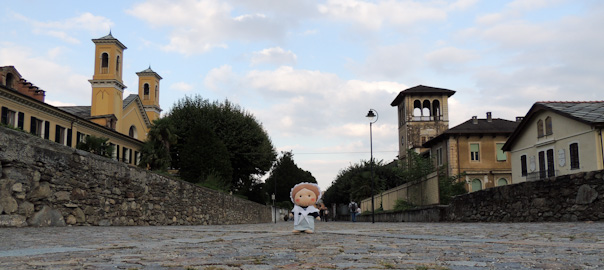Here I am back again, my dear friends!
Today we are in the heart of Torre Pellice, in the area known as “Waldensian Quarter”. It is made of some buildings of great historical and cultural interest and importance; all of them are placed near the central Beckwith street: that road was named after the General Beckwith because of his important work in these valleys and in particular in this town.

Consider that, thanks to Charles Beckwith’s intervention, this area (in the west side of the town) was also called “the Waldensian Sorbonne ” (in honor of the famous University of Paris), since this was the center of the Waldensian Church, both for its administration and for its training and education.
Beckwith, working with some British architects, planned all of these buildings and stood over their construction.
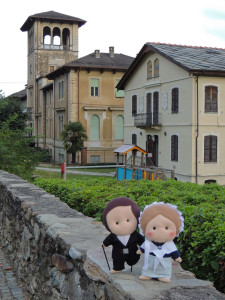
“We Brits love to do things well, Miss!”
Good afternoon, Colonel Beckwith! Why are you round here?
“I love to take a walk after having tea; I knew that today you’d come here, and I thought it would be nice to hang around with you…”
Colonel Beckwith, you financed many works in the Waldensian Valleys, such as this temple. Why did you decide to build one right here?
“Starting from 1700 people who used to live in the villages of the valley began to settle in the plains or in the hamlet of Torre Pellice in order to take advantage of its comforts, and thus the Coppieri temple (which was the only one built in Torre Pellice – because of the agreement of Cavour, became quite uncomfortable to attend.
For this reason, in 1847, I opposed the project of renovation of that temple and I proposed to build a new and nearer one, in Santa Margherita. The following year, on February 17th, 1848, Waldenses achieved emancipation, so it became possible to build the temple in a more central position… and here it is!”
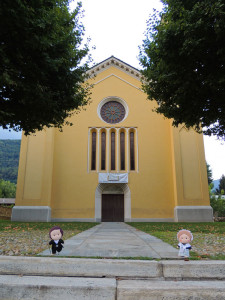
The temple, built in Romanesque style, needed to be large enough to house many people! Even today in this temple the opening cult of the Waldensian Synod is celebrated and, still in this temple, future pastors are canonized.
The Synod, which takes place the last week of August in Torre Pellice, is the general assembly of the Waldensian Church; during this event, representatives from all of the communities throughout Italy gather together to discuss about current problems and issues of ecclesiastical life.
The two lateral steeples remained with no bells for a long time, and only in 1927 a bell was hoisted… A popular saying reads: ” L‘Eglise de la Tour a deux temples, trois clochers et deux sans cloches ” (the church of Torre has two temples, three towers and two without bells. The final part of the tongue-twister sounds also like “deux cents cloches”, which actually means “two hundred bells”!).
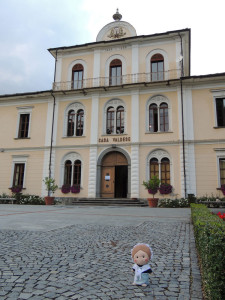
A building designed in 1922 as an orphanage for the children of the fallen of World War I (1915-18), it is now home to the Cultural Center and to the Waldensian Museum.
The museum is divided into two sections: the historical section (where Waldensian history from Middle Ages to today is recounted) and the ethnographic section (which illustrates life in the Valleys between 19th and 20th centuries); the museum houses all of the material that had been collected in 1889 in the Musée Vaudois.
Even today, families of the Valleys offer the museum findings and relics that continuously enrich the museum’s collection.
In this building there is also the Waldensian Library, directly descending from libraries born in years 1830/40 where pastors, teachers, students were educated. At the end of 1880 in the Library there were about 16000 volumes; a century later the number of volumes had increased up to 61000!
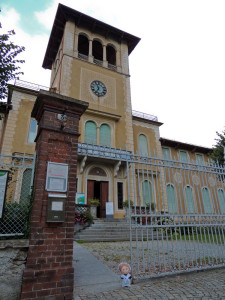
“The Waldensian Boarding School, still active today as language European high school, was built in 1832; young Waldensian would start their education here, and they would complete their higher studies abroad.
A little further upline, on the opposite side of the road, there are also the Professors’ homes, small cottages with an English-looking garden, which used to be residence for the teachers of the Boarding School. ”
Not far away we find the Waldensian Guest Quarter, which is nowadays an important accommodation for tourists who visit the town; the building began (on Beckwith’s initiative) in 1844 as “Pensionnat” (school for girls).
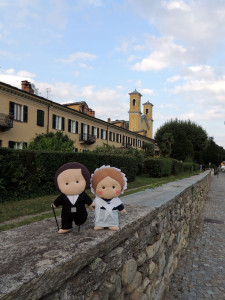
Well, we’re at the end of our walk. These days this area is going to be very crowded because of the Waldensian Synod!
…what are you going to do now, Colonel Beckwith?
“You know what? I think I’m going for another walk. Would you accompany me, milady? ”
As commanded, Colonel Beckwith! …ehm… of course, Colonel Beckwith! It’s a great pleasure!
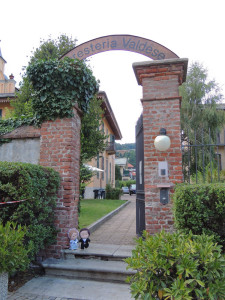
How to get here:
reach the village of Torre Pellice along the Provincial Road 161. Turn right in Valdo Street and reach the pedestrian zone on your left (Beckwith Street).
Do you want to read the tale in Italian ?
